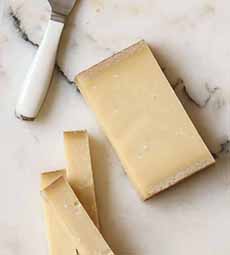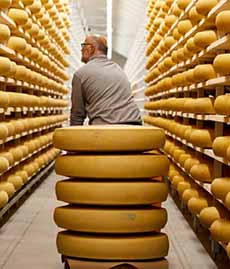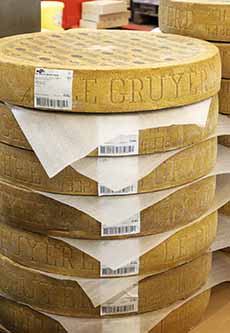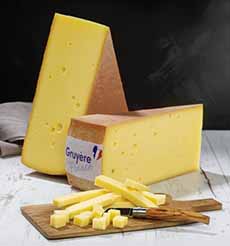The World’s Best Cheese & The History Of Gruyère
|
This year’s World Cheese Awards was held recently at a conference center in Newport, Wales. It was originally to be held in Kyiv, Ukraine, but the location had to be moved due to the Russian invasion. (All fees were waived for the Ukraine entries, and the country had opportunities to showcase its cheeses throughout the day. What a show of cheeses it was: 4,434 cheeses from 42 countries! Cheeses came from as far away as Australia, India, and Japan. Who tasted all that cheese? Some 250 expert judges representing 38 nations. While “the math” indicates that there are just 18 cheeses for each judge to taste, it’s not that simple. Round after round of eliminations requires tasting more and more cheese to whittle down to the category winners, and then on to the semifinals. This year’s overall winner, a Le Gruyère* from Switzerland, was eventually selected by a separate panel of top judges after tasting the 98 “super gold” champions (category winners). The 98 were narrowed to a final 16. How does one choose among 98 category winners to get to the final 16, much less winnow down 16 great cheeses to one winning cheese? A mountain cheese like Gruyère made in huge wheels is so different from a smaller wheel of blue cheese or a delicate log of fresh goat cheese. This is literally is the cheese version of comparing apples to oranges. Vorderfultigen Gourmino Le Gruyère AOP‡ surchoix†, entered by Swiss cheesemaker Vorderfultigen and affineur (refiner) Gourmino, was deemed by the judges to be a “really refined, hand-crafted cheese” that melts on the tongue and has notes of herbs,, fruits and leather. “A cheese with a lot of taste and bouquet” [source]. There are numerous other producers of Le Gruyère, of course, but Vorderfultigen/Gourmino was the winning team this year. An aged cheese, Le Gruyère is slightly crumbly and made from raw part-skim cow’s milk. This is the fourth time that a Le Gruyère cheese has taken the top trophy at the World Cheese Awards. The annual awards are organized by the Guild of Fine Food in the UK. > Here’s more about Le Gruyère AOP. Coming in second place was a Gorgonzola Dolce DOP, a soft, buttery blue cheese from Italy made by De’ Magi. All cheeses are tasted blind. How do you know when you’ve hit on a winner? Tom Chatfield, one of the first group of judges, noted that “Some cheeses have a song that keeps on going. This [cheese that he was tasting] is a 15 second one, but not a full orchestra. Some cheeses will keep singing.” That explains it! > Downloadable pdf of all trophy winners. > Downloadble pdf of the Final 16. > Here’s more about the competition. > The different types of cheese. Millennia ago, cheese was born of the necessity to preserve milk from spoiling. Fresh cheeses were edible for a week or so while aging the cheese provided food down the road and during times of need. While cheesemakers were making the progenitor of Gruyère in the Swiss Alps long before the first written record of it, that written record dates to medieval times: 1115 C.E. It was then that the dairy farmers in the north of Switzerland, around the Alpine town of Gruyères, near the French border gave birth to what would later be called Gruyère. The area, known for its beautiful mountains and valleys (and a popular tourist spot), offered plenty of space for cows to roam and graze. The fresh Alpine air and the sweet grasses in the lush meadows create[d] milk of particularly high quality. Quality milk, no surprise, makes quality cheese, with layers of flavor and fine texture. Over time, Swiss Gruyère earned a reputation across Europe. It transitioned from a staple foodstuff for local laborers into something sought by the wealthy in Switzerland and beyond. Sometime in the 1600s, the cheese got its current name, and Gruyère began to be exported and traded across the continent. As demand for the cheese grew, cheesemakers in France tried to replicate the Swiss Gruyère recipe to build their own sales. The result was that the word “Gruyère” was added to the Académie Francaise, which monitors the French language, in 1762. As a newly-minted “official” word French, Gruyère became an industry for that country’s cheesemakers. French cheesemakers made their own style of Gruyère. Go to purchase Gruyère, and you’ll find that French Gruyère has holes like Swiss Emmenthal (see French Gruyère in photo #8), whereas Swiss Gruyère is solid (see the other photos). A note: While many Americans think of “Swiss cheese” as a hard cheese with holes (like French Gruyère), there are five categories of Swiss cheese (i.e., cheeses made in Switzerland. Take a look. Thus commenced a battle by the original Swiss Gruyère cheesemakers for official recognition as the original Gruyère. From about 1890, the French and the Swiss argued over who should be accorded “official” status. Over the next 100 years, talks were held in Madrid, Paris, and Rome about how Gruyère and many other authentic agricultural products could be protected from imitators. The result was the introduction of Protected Designation of Origin‡ (PDO) status for some of Europe’s most famous foods. It took a long time for Gruyère to get the official designation. Finally, in 2001, it was awarded AOC-protected status in Switzerland (now AOP‡ under the EU). Along with the designation came the requirements that Gruyère AOP had to be made in a specific area of Switzerland, with traditional methods under strict standards. But zut alors! The French also gained AOC protection for their own version of Gruyère. This meant that there were two different cheeses being produced under the name Gruyère. Confusion, anyone? (It’s confusing for almost everyone not involved in the cheese industry!) This led to both the Swiss and French Gruyère producers vying for AOP protection—a step up from each country’s AOC status, AOP is recognized by the EU, and therefore, everywhere. The victor would walk away with the protection needed to sell their cheese as the “original” Gruyère forever. While the French made the first move to claim the AOP for their cheese, the Swiss rightfully complained, pointing out that the cheese was named after one of their own towns and had been made in their country for a lot longer. The EU agreed, and in 2011 Switzerland’s Gruyère was given AOP status and became known as Le Gruyère AOP. While you’ll still find French-made Gruyère (and indeed, other countries make their own versions of Griuere), Switzerland can now claim the original [source]. So if you want the real deal, make sure your Gruyère is stamped AOP. You’ll enjoy the best!
|
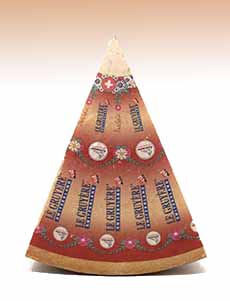 [1] A view from the top: a wedge of the best cheese in the world (photos #1 and #6 © Gourmino).
|
|
|
Postscript: In Europe, protected designations vary by country and there is also the EU standard. Although Gruyère is recognized as a Swiss Geographical Indication in the EU, Gruyère of French origin is also protected as a Protected Geographical Indication (PGI) in the EU. To avoid confusion, the EU PGI Gruyère must indicate that it comes from France and must make sure it cannot be confused with Gruyère from Switzerland. It’s generally sold as “French Gruyère.” U.S. Complication: In 2021, a U.S. District Court ruled that the term “gruyere” had become a generic trademark, and thus that the Swiss and French Gruyère producers’ associations could not register it as a trademark in the United States [source]. †Surchoix (sur-SHWAH) means premier choix (premier choice), or qualité supérieure (superior quality). This “top quality” indicator means that a particular batch of cheese is a cut above the rest. ‡AOP stands for Appellation d’Origine Protégée or translated into English as Protected Designation of Origin (PDO). The letters after the name of the cheese are a designation of quality and authenticity. The designation ensures that the product is made according to traditional standards with time-honored techniques. Appellation d’Origine Contrôlée (AOC) translates to “controlled designation of origin,” which is a classification system in France that is given to certain products, such as wine and cheese.
|
||


